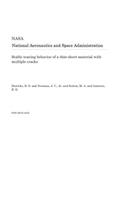
Stable Tearing Behavior of a Thin-Sheet Material with Multiple Cracks
Series:
Fracture tests were conducted on 2.3mm thick, 305mm wide sheets of 2024-T3 aluminum alloy with 1-5 collinear cracks. The cracks were introduced (crack history) into the specimens by three methods: (1) saw cutting; (2) fatigue precracking at a low stress range; and (3) fatigue precracking at a high stress range. For the single crack tests, the initial crack history influenced the stress required fo
NaN
VOLUME
English
Paperback

Fracture tests were conducted on 2.3mm thick, 305mm wide sheets of 2024-T3 aluminum alloy with 1-5 collinear cracks. The cracks were introduced (crack history) into the specimens by three methods: (1) saw cutting; (2) fatigue precracking at a low stress range; and (3) fatigue precracking at a high stress range. For the single crack tests, the initial crack history influenced the stress required for the onset of stable crack growth and the first 10mm of crack growth. The effect on failure stress was about 4 percent or less. For the multiple crack tests, the initial crack history was shown to cause differences of more than 20 percent in the link-up stress and 13 percent in failure stress. An elastic-plastic finite element analysis employing the Crack Tip Opening Angle (CTOA) fracture criterion was used to predict the fracture behavior of the single and multiple crack tests. The numerical predictions were within 7 percent of the observed link-up and failure stress in all the tests. Dawicke, D. S. and Newman, J. C., Jr. and Sutton, M. A. and Amstutz, B. E. Langley Research Center RTOP 538-02-10-01...
Price Comparison [India]
In This Series
Bestseller Manga
Trending NEWS




















